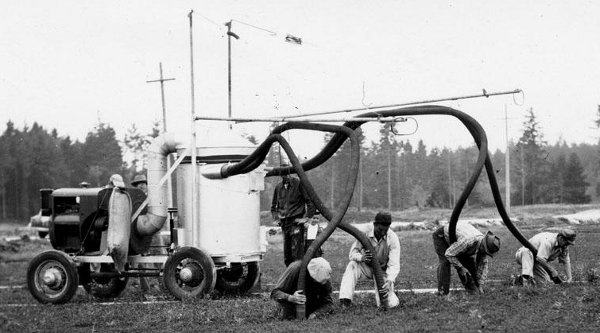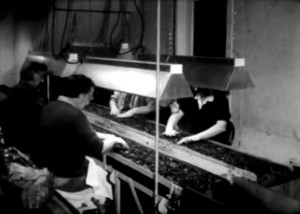Farm History
Established in 1940 by Guy C. Meyers, New York businessman and entrepreneur, Cranguyma Farms, Inc. is still owned by family heirs—now into the fifth generation. The name Cranguyma is a blend of Cranberry, the founder’s first name Guy, and his wife’s first name Amy spelled backwards.
Through the 1950s, Cranguyma was the largest cranberry farm west of the Mississippi River; Cranguyma alone averaged about one per cent of the entire cranberry harvest of the United States. Cranguyma became a national leader in the development of its own cranberry product line in the 1950s. At one time the farm employed over fifty employees and included a cannery, packaging plant, nursery, and gardens.
Dry Harvest
In the farm’s early days, cranberries were “dry-harvested.” Strange devices such as the one pictured below were used to suck berries straight off the vines!

By contrast, cranberries at Cranguyma Farms are wet-harvested today. This entails flooding the bogs with water so that the berries float to the top, then corralling them to a pump.
Railroad
In its heyday, the farm’s bogs were served by its own five-mile-long standard gauge railroad system. The train cars carried the year’s crop to the cannery for production.

Cranguyma Farms rail cart hauling pipe for its sprinkler irrigation system
Cranguyma Farms Product Line

Inside the Cranguyma Farms cannery

The "Indian Harvest" gift pack, marketed as "A gift combination of 8 rare and tangy cranberry delicacies worthy of presentation to the most discriminating people."
In 1952, Cranguyma Farms opened its cannery to develop and produce virtually all types of cranberry products: cranberry juice concentrate, myriad jams and preserves, cranberry sherbet and ice cream topping, cranberry pancake syrup, cranberry coffee cake mix, and, of course, cranberry sauce. Items were sold directly to consumers in gift packs, and to the ice cream and baking industries. The cannery included a research laboratory for extensive testing of new product developments.